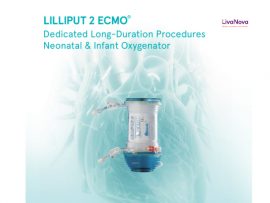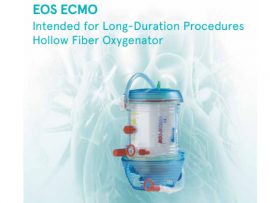Abstract Background Extracorporeal membrane oxygenation (ECMO) stands as a pivotal intervention for patients grappling with cardiopulmonary insufficiency. However, alongside its therapeutic benefits, ECMO carries the risk of complications, with acute..
Lee masAbstract Cardiogenic shock (CS) is a critical condition with high mortality, characterized by reduced cardiac output (CO) and tissue hypoperfusion, despite advancements in treatment. Traditional hemodynamic markers like CO measurements,..
Lee masAbstract Introduction On January 27, 2025, DeepSeek-R1, a new Generative AI model, was introduced and rapidly gained adoption, taking over the user market to become the No.1 downloaded AI app , , ...
Lee masAbstract The use of extracorporeal membrane oxygenation (ECMO) to support the pregnant patient and fetus requires a complex decision-making process. Peripartum ECMO requires coordinated and informed decision-making between an interdisciplinary..
Lee masAbstract Aims Knowing the upper time limit for successful weaning from temporary mechanical circulatory support in cardiogenic shock will help with decision‐making regarding advanced heart failure (HF) therapy or considering..
Lee masAbstract Background: Cardiac surgery-associated acute kidney injury (CSA-AKI) results in poor prognosis. Several risk factors for CSA-AKI have been reported, including preoperative creatinine level, cardiopulmonary bypass time, and perioperative blood pressure..
Lee masAbstract Objective To compare the effects of fluid bolus therapy (FBT) with 20% albumin to crystalloid FBT on the incidence of cardiac surgery–associated acute kidney injury (CSA-AKI) and its severity..
Lee masAbstract Background: Cardiac surgery-associated acute kidney injury (CSA-AKI) is a prevalent complication with poor outcomes, and its early prediction remains a challenging task. Currently available biomarkers for acute kidney injury (AKI)..
Lee masAbstract Platelets are anucleate blood cells traditionally associated with hemostasis but now increasingly recognized for their multifaceted roles in immunity, inflammation, and tissue repair. Advances in platelet proteomics, employing high-throughput..
Lee masAbstract Objectives Cardiac surgery–associated acute kidney injury (CSA-AKI) is a common complication with high morbidity and mortality. This study was designed to determine whether adding human albumin to the cardiopulmonary..
Lee masAbstract Objectives Optimal blood pressure goals during cardiopulmonary bypass (CPB) remain uncertain and new metrics to individualize perfusion targets are needed. Critical closing pressure (Pcrit) is a fundamental property of..
Lee masAbstract Objectives To investigate the safety and efficacy of ANG-3777, a hepatocyte growth factor mimetic, in mitigating the risk of acute kidney injury (AKI) in patients undergoing cardiac surgery with..
Lee masAbstract Background The role of pulsatile versus non-pulsatile flow during cardiopulmonary bypass (CPB) is still in debate. This systematic review aimed to comprehensively assess the impact of pulsatile versus non-pulsatile..
Lee masAbstract Around one-quarter of all patients undergoing cardiac procedures, particularly those on cardiopulmonary bypass, develop cardiac surgery-associated acute kidney injury (CSA-AKI). This complication increases the risk of several serious morbidities..
Lee masAbstract Background Near-infrared spectroscopy (NIRS) enables a non-invasive measurement of tissue oxygen saturation (StO2) in regions illuminated by near-infrared lights. Vascular occlusion test (VOT) serves as a model to artificially..
Lee masAbstract Acute kidney injury (AKI) is a common, heterogeneous, multifactorial condition, which is part of the overarching syndrome of acute kidney diseases and disorders. This condition's incidence highest in low-income..
Lee masAbstract Background Acute kidney injury (AKI) is a significant complication in pediatric patients undergoing cardiac surgery. Iron metabolism-related indicators such as ferritin may predict AKI after adult cardiac surgery. However, it..
Lee masAbstract Background: In the PROTECTION trial, intravenous amino acids (AA) decreased the occurrence of acute kidney injury (AKI) in cardiac surgery patients with cardiopulmonary bypass (CPB). Recruitment of renal functional..
Lee masAbstract Background: Acute kidney injury (AKI) occurs in up to 50% of cardiac surgical patients and is often hemodynamically mediated. Point-of-care ultrasound is a non-invasive tool that has the potential..
Lee masAbstract Background The adoption of minimally invasive cardiac surgery (MICS) has increased over the past 25 to 30 years, driven by advancements in technology and a growing understanding of its..
Lee masAbstract Haemolysis occurring during cardiac surgery with cardiopulmonary bypass (CPB) is assumed to be a risk factor for postoperative acute kidney injury (AKI). Plasma alpha-1 microglobulin (A1M) may have a..
Lee masAbstract Objective: To investigate the effect of sodium bicarbonate Ringer’s solution (BRS) on the degradation of endothelial glycocalyx components in patients undergoing cardiopulmonary bypass (CPB) during cardiac surgery, and to evaluate..
Lee masAbstract Venoarterial extracorporeal membrane oxygenation (VA-ECMO) has been utilized to treat massive pulmonary embolism (PE) accompanied by cardiac arrest or refractory cardiogenic shock. Our team opted for a femoral-femoral approach..
Lee masAbstract Background: Lung transplantation (LTx) is a critical intervention for patients with end-stage lung disease. However, challenges such as donor organ scarcity and post-transplant complications significantly affect its success. Recent..
Lee masAbstract Background While several studies have summarised the clinical effectiveness evidence for extracorporeal membrane oxygenation (ECMO), there are no evidence syntheses of the impact of centres’ ECMO patient volume on..
Lee masAbstract Impactful learning through simulation-based education involves effective planning and design. This can be a complex process requiring educators to master a varied toolkit of analysis tools, learning methodologies, and..
Lee masPhysicians often place patients on extracorporeal membrane oxygenation (ECMO) support because they expect them either to recover with additional support or to become candidates for transplant or mechanical support. If..
Lee masAbstract Background Acute kidney injury (AKI) is a frequent and important complication of cardiac surgery. Decreased perfusion is a key mechanism. This decreased perfusion may be attenuated by intravenous amino..
Lee masAbstract Background Cardiac arrest in pregnancy is rare. Clinicians need to adapt management to the altered anatomy and physiology of pregnancy, and the well-being of two patients (mother and foetus)..
Lee masAbstract Children requiring veno-arterial extracorporeal membrane oxygenation (VA ECMO) or cardiac surgery often undergo cervical cannulation or carotid artery clamping, which can interrupt cerebral circulation. Inadequate collateral flow through the..
Lee mas





















